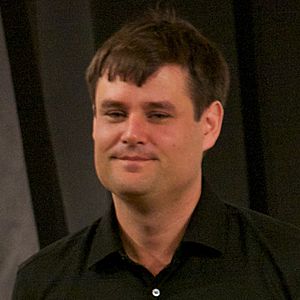Michael Nielsen facts for kids
Quick facts for kids
Michael Nielsen
|
|
|---|---|

Michael Nielsen at Science Online London 2011
|
|
| Born |
Michael Aaron Nielsen
January 4, 1974 |
| Nationality | Australian, American |
| Alma mater | University of New Mexico |
| Known for | Quantum Computation and Quantum Information Nielsen's theorem |
| Awards | Richard C. Tolman Prize Fellow at Caltech, Fulbright Scholar |
| Scientific career | |
| Fields | Physics, Computer science |
| Institutions | Los Alamos National Laboratory Caltech University of Queensland Perimeter Institute Recurse Center |
| Thesis | Quantum Information Theory (1998) |
| Doctoral advisor | Carlton M. Caves |
Michael Aaron Nielsen, born on January 4, 1974, is a scientist from Australia and America. He is a quantum physicist, which means he studies the tiny world of atoms and particles. He also writes about science and researches computer programming. He lives in San Francisco.
Contents
Michael Nielsen's Work and Research
Michael Nielsen earned his PhD in physics in 1998 from the University of New Mexico. A PhD is a very high university degree. In 2004, he was called Australia's "youngest academic." He received a special award called a Federation Fellowship at the University of Queensland. During this time, he worked at important places like the Los Alamos National Laboratory and Caltech. He also worked at the Perimeter Institute for Theoretical Physics.
Quantum Computing and Collaboration
Michael Nielsen worked with another scientist, Isaac Chuang. Together, they wrote a very popular textbook about quantum computing. This book, called Quantum Computation and Quantum Information, has been used by many researchers. As of July 2025, it has been mentioned in over 52,000 other scientific papers.
Around 2007, Nielsen started focusing on new ways for scientists to work together. He also looked at how they could share their research more easily. He helped create the Polymath project with Timothy Gowers. This project helps many mathematicians work together on problems at the same time.
Open Science and Learning
Michael Nielsen strongly believes in "open science." This means making scientific research and data available to everyone. He has written a lot about this idea, including in his book Reinventing Discovery. This book was praised by the science magazine Nature. The Financial Times also named it one of the best books of 2011.
In 2015, Nielsen published an online textbook called Neural Networks and Deep Learning. This book teaches about how computers can learn, similar to how our brains work. He then joined the Recurse Center as a Research Fellow for a year. From 2016 to 2019, he was a Research Fellow at Y Combinator Research.
In 2019, Michael Nielsen worked with Andy Matuschak. They created an online series of interactive essays called Quantum Computing for the Very Curious. These essays help explain quantum computing and quantum mechanics in an engaging way. He also researched with Patrick Collison to see if scientific progress might be slowing down.
Michael Nielsen continues to live and work in San Francisco.
See also
 In Spanish: Michael Nielsen para niños
In Spanish: Michael Nielsen para niños

